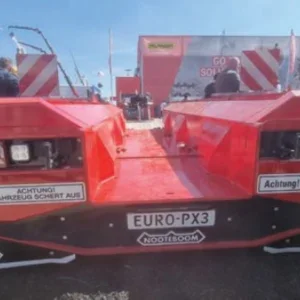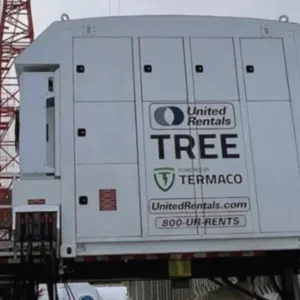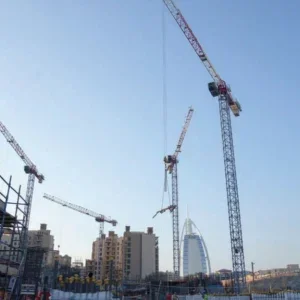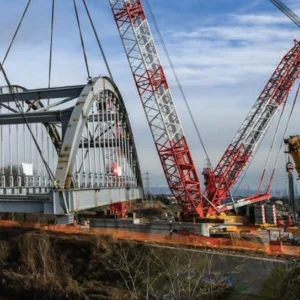Loader crane manufacturers never stand still in their tireless quest to improve their product ranges, be it through the increased use of modular components, electronics, or higher grade materials. Modularity, for example, has been particularly embraced by Hiab, with its new XS range which was heavily promoted last year (CT Oct 2000, p9).
New at Italy’s SAIE construction show last October were several models from domestic manufacturers. Cormach showed its 27500 E6F ASC, derived from the 25500E and the second model in the 27500 range. It can have a four extension fly jib and six extensions on the basic boom or, for example, just two extensions. Even when fitted with a winch, the 27500 is completely foldable, claims export manager Giulio De Luca. Total height is 30m and at the maximum horizontal outreach it lifts 230kg. Radio control is fitted as standard to all ASC models and a proportional Danfoss valve block is used. Long booms are now very popular, according to De Luca and virtually all long boom models are shipped with radio control.
Another new Cormach model, in the Tech range, is the 32 Basket Tech, based on the model 23000. It is an aerial device that can also be used as a crane, unusual in that such products are generally based on a crane design that can also be used with a basket. Technical differences are minimal between the 23000 and the 32 Basket Tech. The biggest difference is that a crane uses cables to retract the boom sections whereas the aerial platform version uses chains which are slightly heavier. A special basket connection is made with just two removable pins. Conversion is further simplified by having the winch pulley built in permanently. A changeover time of about 10 minutes is claimed, to wire up and switch between crane and aerial device.
It has a 32m working height when mounted on a 9t GVW truck. Though developed for the Italian market, Germany is also targeted, particularly because it is designed for maximum reach on the smallest possible chassis. For the same reason De Luca also sees potential in the USA. There is a special subframe, a simple boom shape (not hexagonal), and very thin, high grade Weldox 900 steel is used. Launches for this year will include new wallboard handling models, particularly popular in the USA.
New at SAIE from Fratelli Ferrari were three models in the 300 series, one in the 500 series and two in the 700 series. The 310, rated at 0.93tm, is a stiff-boom crane, with either manual, hydraulic or electro- hydraulic operation. Light weight is a feature, ranging from 100kg for the manual version to 175kg for a hydraulic one with two extensions. The 540 replaces the 535 and has an extra hydraulic extension and more capacity but only weighs 15kg more. The 715 can have as many as six hydraulic extensions, and can have extra-extendable stabilisers to give a 6m spread.
Amco Veba showed its new 832C at SAIE, available in short boom and long boom versions, and the new A35, a 35tm model available with a maximum of eight hydraulic extensions. Also new, but not exhibited, is a 4tm model with four hydraulic extensions, and similarly, the 702k, for the Japanese market and other countries where narrow trucks are popular. The 702k has a reduced maximum width and a low price, according to company president Giancarlo Perego. Launches this year are to include a 65tm model.
Amco Veba’s biggest market is now the USA which, according to Perego proves that both quality and strategy are right. Service cranes are an important niche for Amco Veba in the USA, he says. Niche markets continue to be a strong area for the company, contributing to tripled turnover in the last four years and a projected 30% growth for 2000.
Amco Veba is well established in the recovery crane sector which continues to thrive. A recent boost in the UK has come from several recent contract renewals for 10-year-old cranes. Requirements in this sector are increasingly for higher capacity models than the original 10tm cranes because these are not large enough to handle sports utility vehicles (SUVs) that are so popular now, and weigh 2t. Amco Veba’s range is from 1.5tm to 17tm in the T-boom configuration and includes a new 15tm model.
Amco Veba models in the 32tm and 35tm classes have the longest reach in the market, Perego claims, as they can have up to eight extensions. Independent extension cylinders are used as they are quicker and more reliable than multi-section cylinders, Perego says. In addition, the final extension cylinder is side mounted for minimum height to give access through small openings such as windows. Other manufacturers stack their rams on top of each other, Perego says. For faster extension, Amco Veba offers a two lever extension method instead of the standard single lever sequential extension sequence. On an eight extension crane, for example, two sets of four extensions can be extended at the same time rather than one after the other. The new 832 models have this two lever extension system on a dual hydraulic circuit.
Austrian crane builder Rochus Penz is looking for international partners, such as truck assemblers, service stations and workshops, to expand abroad. Penz was set up in 1966 and its first product was a timber loading crane. The company, now with 90 employees and subsidiaries in Germany and Brazil, specialises in mobile and static timber handling cranes, special cranes for fire services and crane equipment for tunnelling machines. Turnover is about ATS120m ($8.5m) from an annual production of around 250 units, about 35% of which are exported, according to the company.
Over in Germany, Tirre has improved the power to weight ratio of its loader crane range to give more performance without adding weight. Hydraulic lines have also been re-routed for easier maintenance, and there are larger diameter pin connections to reduce wear. The Euro 142 is a 14tm unit for general use in the haulage industry with further application for transport companies that deliver, for example, steel or machinery. Outrigger stabiliser width is 6.3m. Further up the range, between the Euro 202 and Euro 262, there is a new 2t capacity jib, with three section hydraulic extension.
HMF of Denmark launched its HMF 760 and 910 series models at the September 2000 IAA commercial vehicle show in Frankfurt, Germany. The 760 and 910 are aimed at a wide range of applications using hooks and hydraulic accessories, such as grabs, and are designed for fast operation with long outreach and low weight.
The modular boom design means up to four extensions can be added using a ‘bolt-on’ system. Oil regeneration on the extension system increases working speed and a new stabiliser system allows their length to be varied by turning the stabiliser beam around.
Maximum reach of the 760 with four hydraulic extensions is 10.2m, where the lifting capacity is 580kg. Manual extension increases the reach to 11.9m, where the lifting capacity is 500kg. The 910 has a maximum hydraulic outreach of 11m where the lifting capacity is 640kg. In K1 form, with one extension, the 910 lifts 1.6t at a horizontal outreach of 5.4m. Standard in Europe and an optional extra elsewhere, both models have the RCL 5100 limiting device to prevent overload situations.
In the USA, Iowa Mold Tooling (IMT) has a distribution agreement with HMF. This year it is introducing several new HMF models to the USA with capacities of 16tm and larger, according to sales and marketing vice president Mark Whaley. One particular model is the result of a joint design effort. These cranes will be replacing similar capacity models previously supplied by PM of Italy. IMT is no longer handling the PM range and during 2000 only remaining stock was sold. Unit sales figures are not released by IMT, but Whaley says: “Sales of HMF product have exceeded our original projections and are expected to become a significant portion of IMT’s total sales within the next 24 month period. Product performance has been excellent.”






